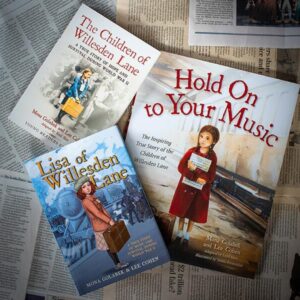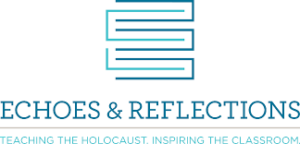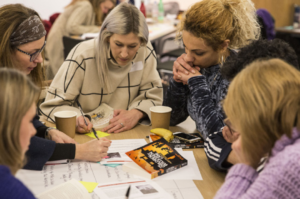The Institute for Holocaust Education is proud to partner with Hold On To Your Music Foundation.
Supported by leading Holocaust education organizations; the USC Shoah Foundation and Echoes & Reflections.


14-year-old Holocaust survivor Lisa Jura’s universal story of bravery and resilience transforms classrooms around the world in an interdisciplinary and multisensory learning experience. The Willesden Project is a partnership of the USC Shoah Foundation and Hold On To Your Music Foundation with support from the Koret Foundation. This suite of resources blends music, story and technology to reshape Holocaust education for primary and secondary school students.

Echoes & Reflections is committed to partnering with educators to foster confidence and amplify the skills needed to teach about the Holocaust in a comprehensive and meaningful way.



How do stories transcend generations, convey meaning and purpose about events of the past and help us to better understand ourselves and others today?
See how you and your students can address this essential question by using the Final Project Framework – designed for Nebraska Standards.

Lesson: Leaving – Becoming a Refugee
Topic: Cross-Cultural Understanding, Empathy, Legacy, Critical Thinking
Grade Level: 5
Time: 60-90 minutes
Subject Area: English Language Arts, Social Studies, Secondary Holocaust Education, Social Emotional Learning, Visual and Performing Arts
Alignment to Lisa of Willesden Lane: Chapters 1-4
DESCRIPTION OF THE LESSON: In this lesson, students will recognize that sometimes individuals leave all they know, not because they want to, but because of the threat of persecution, oppression, and even death.
SECTION SUMMARY OF LISA OF WILLESDEN LANE: In this section we meet Lisa Jura, a fourteen-year-old music prodigy living in prewar Vienna when her family and neighbors experience unfair and cruel treatment because they are Jewish. Wishing to keep their children safe, Lisa’s parents, Malka and Abraham, choose to send their daughter to safety in England on the Kindertransport. Lisa arrives at Bloomsbury House in London as a refugee and is quickly placed as a housemaid to a rich family in the countryside. Although she was treated kindly, Lisa soon realizes that she will be unable to realize her dreams of becoming a concert pianist if she remains there. Lisa resourcefully returns to Bloomsbury House, surprising Mr. Hardesty with her courageous and unexpected return to London. He places Lisa in a hostel with other Jewish child refugees at 243 Willesden Lane. Lisa quickly adjusts to her new home, where she has a piano to play and is able to make new friends with the other children.
MATERIALS:
LEARNING AIMS:
ESSENTIAL QUESTIONS:
LESSON PLAN:
EXTENSION ACTIVITIES:

Lesson: Belonging
Topic: Cross-Cultural Understanding, Empathy, Legacy, Critical Thinking
Grade Level: 5
Time: 60-90 minutes
Subject Area: English Language Arts, Social Studies, Secondary Holocaust Education, Social Emotional Learning, Visual and Performing Arts
Alignment to Lisa of Willesden Lane: Chapters 5-8
DESCRIPTION OF THE LESSON: In this lesson, students will recognize that shared interests, values, and goals can build a sense of belonging.
SECTION SUMMARY OF THE CHILDREN OF WILLESDEN LANE: In this section, Lisa settles into her new life at 243 Willesden Lane, and feels a sense of belonging with new friends who are just like herself. Lisa also begins her strenuous work in a garment factory sewing men’s pants and continues to explore ways to get her sister Sonja out of Vienna. Eventually, a Quaker family agrees to sponsor Sonja who arrives on a Kindertransport as Britain declares war on Germany. As the London Blitz begins Lisa decides to organize a little music concert on New Year’s Day to give other refugees hope during the difficult time. Mrs. Cohen encourages Lisa to audition for The London Royal Academy of Music. Despite Lisa’s initial hesitation, she agrees, in order to keep her promise to her mother, “to make something of herself.”
MATERIALS:
LEARNING AIMS:
ESSENTIAL QUESTIONS:
LESSON PLAN:
EXTENSION ACTIVITIES:

Lesson: Preserving
Topic: Cross-Cultural Understanding, Empathy, Legacy, Critical Thinking
Grade Level: 5
Time: 60-90 minutes
Subject Area: English Language Arts, Social Studies, Secondary Holocaust Education, Social Emotional Learning, Visual and Performing Arts
Alignment to Lisa of Willesden Lane: Chapters 9-12
DESCRIPTION OF THE LESSON: In this lesson, students will recognize that obstacles in life will always occur and is how we cope with conflict which leads to a stronger, resilient individual. Resilience is defined as “an ability to recover from or adjust to misfortune or change” and perseverance is defined as “The continued effort to do or achieve something despite difficulties or failure.”
SECTION SUMMARY OF THE CHILDREN OF WILLESDEN LANE: Lisa picks up her application from the Royal Academy of Music and begins deciding on the pieces of music she will play for the audition. After the American naval base of Pearl Harbor is bombed, the United States joins in the war efforts. The ladies from work pitch in and buy Lisa a beautiful dress to wear for her audition. On audition day she noticed she was the only one who was not accompanied by a parent. As she played for the judges, she imagined she was playing for her parents and her sisters although they were far away. Lisa lifts everyone’s spirts at 243 Willesden Lane after being accepted in the Royal Academy of Music. She leaves her factory job to play piano at the Howard Hotel. The war ended and everyone waits anxiously to hear news of their families and loved ones.
MATERIALS:
LEARNING AIMS:
ESSENTIAL QUESTIONS:
LESSON PLAN:
EXTENSION ACTIVITIES:

Lesson: Triumphing
Topic: Cross-Cultural Understanding, Empathy, Legacy, Critical Thinking
Grade Level: 5
Time: 60-90 minutes
Subject Area: English Language Arts, Social Studies, Secondary Holocaust Education, Social Emotional Learning, Visual and Performing Arts
Alignment to Lisa of Willesden Lane: Chapters 13-14 & Epilogue
DESCRIPTION OF THE LESSON: In this lesson, students will recognize that personal goals, inspiration, support and shared interests with family friends, and community contribute to one’s ability to overcome and triumph over the most challenging times.
SECTION SUMMARY OF THE CHILDREN OF WILLESDEN LANE: After the war, Lisa moved in with the Quaker woman Mrs. Canfield to make room for the younger children who had been displaced during the war. She was reunited with her sisters Rosie and Sonja, but her parents did not survive the Holocaust. Lisa kept her promise to her mother to make something of herself as she made her debut at the Grand Royal Hall, and the children of Willesden Lane and women from the factory came to cheer her on.
MATERIALS:
LEARNING AIMS:
ESSENTIAL QUESTIONS:
LESSON PLAN:
EXTENSION ACTIVITIES:

Lesson: Leaving – Becoming a Refugee
Topic: Cross-Cultural Understanding, Empathy, Legacy, Critical Thinking
Grade Level: 6-8
Time: 60-90 minutes
Subject Area: English Language Arts, Social Studies, Secondary Holocaust Education, Social Emotional Learning, Visual and Performing Arts
Alignment to The Children of Willesden Lane: Chapters 1-4
DESCRIPTION OF THE LESSON: In this lesson, students will consider the enduring understanding that sometimes individuals leave all they know, not because they want to, but because of the threat of persecution, oppression, and death.
SECTION SUMMARY OF THE CHILDREN OF WILLESDEN LANE: This section begins with fourteen-year-old music prodigy Lisa Jura and her family living in pre-war Vienna. Lisa, her family, and her neighbors experience unfair and cruel situations due to Nazi occupation, the Nuremburg Laws, and Kristallnacht, simply because they are Jewish. To keep their children safe, Malka and Abraham Jura choose to send Lisa away to safety in England via the Kindertransport, intending to send Sonia and Rosa at a later time. Lisa unwillingly separates from her family and takes the Kindertransport train to a ship which will carry her to England and to safety.
MATERIALS:
LEARNING AIMS:
ESSENTIAL QUESTIONS:
[her] on a rescue operation such as the Kindertransport?
LESSON PLAN:
EXTENSION ACTIVITIES:
Small Group Work: In small groups, have students explore Echoes & Reflections Interactive Timeline for additional information about the events taking place during this period in history. Complete The Children of Willesden Lane Historical Timeline (Middle School) found on page 51-52 of the Teacher Guide for chapters 1-4.

Lesson: Belonging
Topic: Cross-Cultural Understanding, Empathy, Legacy, Critical Thinking
Grade Level: 6-8
Time: 60-90 minutes
Subject Area: English Language Arts, Social Studies, Secondary Holocaust Education, Social Emotional Learning, Visual and Performing Arts
Alignment to The Children of Willesden Lane: Chapters 5-13
DESCRIPTION OF THE LESSON: In this lesson, students will consider the enduring understanding that shared interests, values, and goals can build a sense of belonging.
SECTION SUMMARY OF THE CHILDREN OF WILLESDEN LANE: In this section, the Kindertransport takes Lisa to Bloomsbury House in London where she’s then placed with an English family in the countryside. Although treated kindly, Lisa realizes she’s not meant to live with this family; Lisa resourcefully returns to Bloomsbury House, surprising Mr. Hardesty with her resilient and unexpected return. Mr. Hardesty decides to place her in a hostel with other Jewish refugees like herself at 243 Willesden Lane. Lisa settles in at 243 Willesden Lane, where she gains a job in a garment factory, a piano to play, a chance to see her sister Sonia, and a sense of belonging with new friends who are just like Lisa.
MATERIALS:
LEARNING AIMS:
ESSENTIAL QUESTIONS:
LESSON PLAN:
EXTENSION ACTIVITIES:
Small Group Work: In small groups, have students explore Echoes & Reflections Interactive Timeline for additional information about the events taking place during this period in history. Complete The Children of Willesden Lane Historical Timeline (Middle School) found on page 51-52 of the Teacher Guide for chapters 5-13.

Lesson: Persevering
Topic: Cross-Cultural Understanding, Empathy, Legacy, Critical Thinking
Grade Level: 6-8
Time: 60-90 minutes
Subject Area: English Language Arts, Social Studies, Secondary Holocaust Education, Social Emotional Learning, Visual and Performing Arts
Alignment to The Children of Willesden Lane: Chapters 14-20
DESCRIPTION OF THE LESSON: In this lesson, students will consider that obstacles in life will always occur, and it is how we cope with conflict which leads to a stronger, resilient individual.
SECTION SUMMARY OF THE CHILDREN OF WILLESDEN LANE: This section begins in 1940 with the start of the German “lightning war” on England. The bombing of London during the Blitz alters the lives of the children of Willesden Lane, bringing hardships, sickness, and low morale. There are moments of positivity, as well, including Lisa’s and her friends’ plans to uplift people’s spirits with a “musicale”, an opportunity for Lisa to audition for England’s Royal Academy of Music, and, finally, long-awaited news about Lisa’s family.
MATERIALS:
LEARNING AIMS:
ESSENTIAL QUESTIONS:
LESSON PLAN:
EXTENSION ACTIVITIES:

Lesson: Triumphing
Topic: Cross-Cultural Understanding, Empathy, Legacy, Critical Thinking
Grade Level: 6-8
Time: 60-90 minutes
Subject Area: English Language Arts, Social Studies, Secondary Holocaust Education, Social Emotional Learning, Visual and Performing Arts
Alignment to The Children of Willesden Lane: Chapters 21-26 & Epilogue
DESCRIPTION OF THE LESSON: In this lesson, students will consider that personal goals, inspiration, support and shared interests with family, friends, and community contribute to one’s ability to overcome and triumph over the most challenging of times.
SECTION SUMMARY OF THE CHILDREN OF WILLESDEN LANE: In the section, Lisa and the children of Willesden Lane experience moments of hope and inspiration as the Allies gain more and more victories in the war. Lisa and her friends also experience pain and loss, as well. As this section nears the end, Lisa gives her musical debut at Wigmore Hall, where she uses the music of the piano to narrate the tragedies and triumphs she, her family, her friends, and the war-torn of London, have experienced since the outset of Lisa’s journey on the Kindertransport from Austria.
MATERIALS:
LEARNING AIMS:
ESSENTIAL QUESTIONS:
LESSON PLAN:
EXTENSION ACTIVITIES:
Note: This activity includes the testimony of Ivy Schamis, a survivor of the February 14, 2018, Marjory Stoneman Douglas High School shooting. And this activity asks students to reflect on their own experiences during the Covid-19 pandemic. Please refer to the Pedagogical Principles provided by Echoes & Reflections for further guidance on how to create a safe and supportive learning environment.
By signing up for the Willesden Lane in the Midwest; Nebraska and Western Iowa educators can receive a classroom set for either "The Children of Willesden Lane: Young Readers Edition" or "Lisa of Willesden Lane" for their classroom usage at NO COST. Nebraska and Western Iowa educators will also have the opportunity to have professional development, corresponding curriculum, and a cumulative final project.